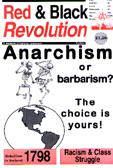Over 30 years of anarchist writing from Ireland listed under hundreds of topics
Cities of the future?
Purchase's proposal for more ecologically integrated communities usually meets with most scepticism when it is imagined applied to cities. Even a relatively small city, like Dublin, is almost completely dependent on food from neighbouring regions, and its ecosystem is made up of cars, people and concrete. If a city like New York or Mexico was sealed off from the rest of the world, it would die within days; the only question is whether it would be from starvation or asphyxiation. Given the number of such large cities around the world, and the fact that, even if it were possible, given the size of the earth's population, for everyone to live in small towns and rural communities, many would not want to, how can cities be accommodated within an environmentally sound anarchist society?
It's an obvious point, but cities did not spring into existence fully formed, with all their support networks intact. Like any community, initially they produced most of their food themselves, but as the industrial base increased, the demand for land for industry and accommodation for the workforce grew, forcing food production into the hinterland. Most cities, even up to recently, would have had small farms comparatively close to the town centre. The supercities of today are only possible because of advances in food preservation (through chemical additives and refrigeration) and transport. Before these advances, the pressure for a city to grow in size was met by the necessity to have enough farms, near enough, to produce the food. Nor is the ejection of agriculture from the city irreversible - during the Second World War, for example, food shortages in Britain led to an immense drive towards small-plot urban farming, something of which has continued to this day in the 'allotments' scheme.
Cities, in Purchase's model would continue to exist, but agriculture would be reintroduced to the residential/commercial mix. There are different ways of doing this - you could divide the city into sectors, with each concentrating on a particular use of the land, aiming at sufficiency on a city-wide scale. Or, and this is more in line with the overall project, each sector would be a community in itself, diversity being brought down to a more local level. ('Sufficiency' is used here as an ideal, not expected to be reached. Cities would still be more densely populated than other areas, and so more likely to be a base for industry and other labour-intensive activities, the aim is to reduce the dependence on other areas for food.) Food production would be integrated into the city - cattle grazing on green spaces, lawns turned into vegetable patches, small neighbourhood farms. Between the demands of industry and accommodation, argues Purchase, there are spaces which in a properly planned city could be filled with life.
The immediate question is whether this could ever be more than a gesture. Sure, some farming could be integrated into urban life, but could it ever come close to meeting the needs of those who live in the city? If we are to continue to have the same population density, and the same concentration of industry in our cities, can these urban farms ever be more than a supplement to large-scale farming elsewhere, a token 'greening' of the city? If cities were to seriously approach self-sufficiency, wouldn't this necessitate a huge expansion in their size, or a fundamental change in the nature of urban life? Do we want, or need, such a change?
This article is from Red and Black Revolution 4, published November 2000

Read the rest of the articles in this issue online at http://www.wsm.ie/story/1887
Download the PDF file from http://struggle.ws/pdfs/RBR4.pdf
Read all the issues of Red and Black Revolution at http://www.wsm.ie/rbr

